
Clayton is a town in and the county seat of Barbour County, Alabama, United States. The population was 3,008 at the 2010 census, up from 1,475 in 2000.
Christ Episcopal Church is a historic church building in Tuscaloosa, Alabama. It was organized on January 7, 1828, by thirteen men who elected the first vestry that night. In the first year, the vestry hired the architect William Nichols to design the building and oversee its construction. The building was added to the Alabama Register of Landmarks and Heritage on July 28, 1975.

Grace Church is a historic parish church in Manhattan, New York City which is part of the Episcopal Diocese of New York. The church is located at 800–804 Broadway, at the corner of East 10th Street, where Broadway bends to the south-southeast, bringing it in alignment with the avenues in Manhattan's grid. Grace Church School and the church houses—which are now used by the school—are located to the east at 86–98 Fourth Avenue between East 10th and 12th Streets. In 2021, it reported 1,038 members, average attendance of 212, and $1,034,712 in plate and pledge income.

St. John African Methodist Episcopal Church was the first church for African Americans in Nebraska, organized in North Omaha in 1867. It is located at 2402 North 22nd Street in the Near North Side neighborhood. The building is listed on the National Register of Historic Places. The building was constructed in the center of Omaha's North Side in the Prairie School architecture style. Prairie School architecture is rare, and this architectural gem in urban Nebraska is particularly unusual for being designed and built in the 1920s, after the Prairie Style's rapid loss of popularity beginning after 1914.
The Alabama Register of Landmarks and Heritage, commonly referred to as the Alabama Register, is an official listing of buildings, sites, structures, objects, and districts deemed worthy of preservation in the U.S. state of Alabama. These properties, which may be of national, state, and local significance, are designated by the Alabama Historical Commission. The designation is honorary and carries no direct restrictions or incentives. The register includes properties such as cemeteries, churches, moved properties, reconstructed properties, and properties at least 40 years old which may not normally qualify for listing in the National Register of Historic Places. There are approximately 1421 properties and districts listed on the Alabama Register. Of these, approximately 196 are also listed on the National Register of Historic Places and 5 are designated as National Historic Landmarks.
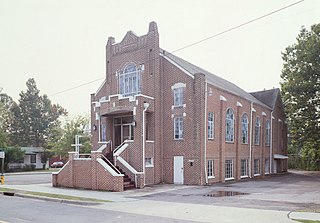
Bethel Baptist Church is a Baptist church in the Collegeville neighborhood of Birmingham, Alabama. The church served as headquarters from 1956 to 1961 for the Alabama Christian Movement for Human Rights (ACMHR), which was led by Fred Shuttlesworth and active in the Birmingham during the Civil Rights Movement. The ACMHR focused on legal and nonviolent direct action against segregated accommodations, transportation, schools and employment discrimination. It played a crucial role in the 1961 Freedom Rides that resulted in federal enforcement of U.S. Supreme Court and Interstate Commerce Commission rulings to desegregate public transportation.
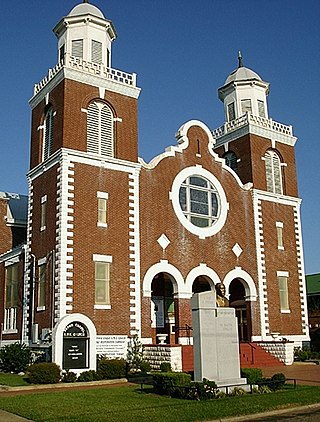
Brown Chapel A.M.E. Church is a church at 410 Martin Luther King Jr. Boulevard in Selma, Alabama, United States. This church was a starting point for the Selma to Montgomery marches in 1965 and, as the meeting place and offices of the Southern Christian Leadership Conference (SCLC) during the Selma Movement, played a major role in the events that led to the adoption of the Voting Rights Act of 1965. The nation's reaction to Selma's "Bloody Sunday" march is widely credited with making the passage of the Voting Rights Act politically viable in the United States Congress.

St. Michael and All Angels Episcopal Church is an historic church located at 1000 West 18th Street in Anniston, Alabama, designed by architect William Halsey Wood of Newark, NJ. It was added to the Alabama Register of Landmarks and Heritage on November 23, 1976, and to the National Register of Historic Places on March 14, 1978.

St. Martin of Tours Episcopal Church is a historic stone Episcopal church building located at 2312 J Street in the South Omaha district of Omaha, Nebraska. Built in 1899 in the Late Gothic Revival style, it was designated an Omaha Landmark and listed on the National Register of Historic Places in 1982. It was the first Episcopal church established in South Omaha when the town was being developed. It is the only surviving Episcopal church in this community, which was settled chiefly by Catholic immigrants.

The Church of the Immaculate Conception and Clergy House at 406–412 East 14th Street between First Avenue and Avenue A in the East Village neighborhood of Manhattan, New York City were built in 1894–1896 by Grace Church, one of the most prominent Episcopal churches in the city at the time. The buildings were a free chapel – meaning there was no pew rent – called Grace Chapel and a connected Grace Hospital, which could serve 16 senior citizens and 10 children, and was physically connected to the chapel by a bridge, so that patients could be wheeled to services.

Grace Episcopal Church Complex is a historic Episcopal church complex at 155-15 Jamaica Avenue in Jamaica, Queens, New York City, in U.S. state of New York. The complex includes the church, parish house, and cemetery. The church was built between 1861 and 1862. It is constructed of rough-cut sandstone and features a steeply pitched roof and tall, sharp spire in the Gothic Revival style. A chancel, designed by Cady, Berg & See, was added at the rear of the church in 1901-1902. The parish house, known as Grace Memorial House, was built in 1912. It is three-story brick building in the Tudor Revival style. The surrounding cemetery includes burials dating to 1734, when the church located at this site. Notable interments include Rufus King (1755–1827), Charles King (1789–1867) and William Duer (1743–1799).
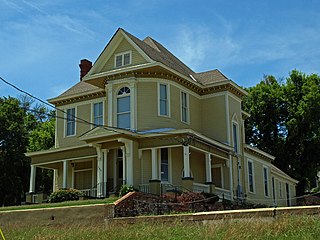
The Cottage Hill Historic District is a 42-acre (17 ha) historic district in Montgomery, Alabama. It is roughly bounded by Goldthwaite, Maxwell, Holt, and Clayton streets and contains 116 contributing buildings, the majority of them in the Queen Anne style. The district was placed on the Alabama Register of Landmarks and Heritage on April 16, 1975, and the National Register of Historic Places on November 7, 1976.
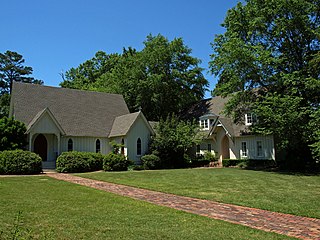
Grace Episcopal Church is a historic Episcopal church in Mount Meigs, Alabama. The Carpenter Gothic structure was built in 1892. The building was placed on the Alabama Register of Landmarks and Heritage on January 29, 1980, and the National Register of Historic Places on February 19, 1982.

Old Ship African Methodist Episcopal Zion Church is a historic African Methodist Episcopal Zion Church in Montgomery, Alabama. It is the oldest African American church congregation in the city, established in 1852. The current Classical Revival-style building was designed by Jim Alexander and was completed in 1918. It is the fourth building the congregation has erected at this location. Scenes from the 1982 television movie Sister, Sister were shot at the church. It was placed on the Alabama Register of Landmarks and Heritage on March 3, 1976, and the National Register of Historic Places on January 24, 1991.

Grace Church or Grace Episcopal Church is a historic Episcopal church located at 600 Cleveland Avenue in Plainfield, Union County, New Jersey, United States. It was added to the National Register of Historic Places on May 10, 2002, for its significance in architecture, art, and music from 1892 to 1930.

Grace Episcopal Church is a historic church at 1115 36th Street in Galveston, Texas. It was built in 1894 and added to the National Register in 1975.
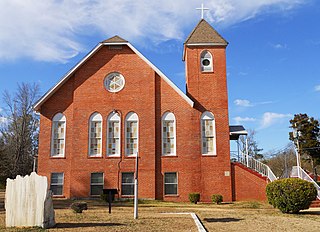
Butler Chapel African Methodist Episcopal Zion Church is a historic church at 1002 N. Church Street in Tuskegee, Alabama. Built in 1957, it was added to the Alabama Register of Landmarks and Heritage in 1985 and the National Register of Historic Places in 1995. It was an important location associated with the civil rights movement of the 1950s and '60s.
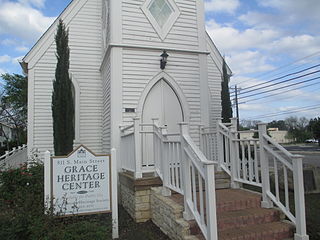
Grace Heritage Center is a church building located at 817 South Main Street in Georgetown, Texas, United States. Built in 1881, the building is the city's oldest wood-framed church.

All Saints' Episcopal Church is a historic Episcopal parish church in Austin, Texas, United States. Built in 1899 on the edge of the University of Texas at Austin campus, the church has long-standing connections with the university's student body and faculty. The chapel was a project of Episcopal Bishop George Herbert Kinsolving, whose crypt is located under the church. It has been designated as a City of Austin Historic Landmark since 1980 and a Recorded Texas Historic Landmark since 2014, and it was listed on the National Register of Historic Places in 2015.





















